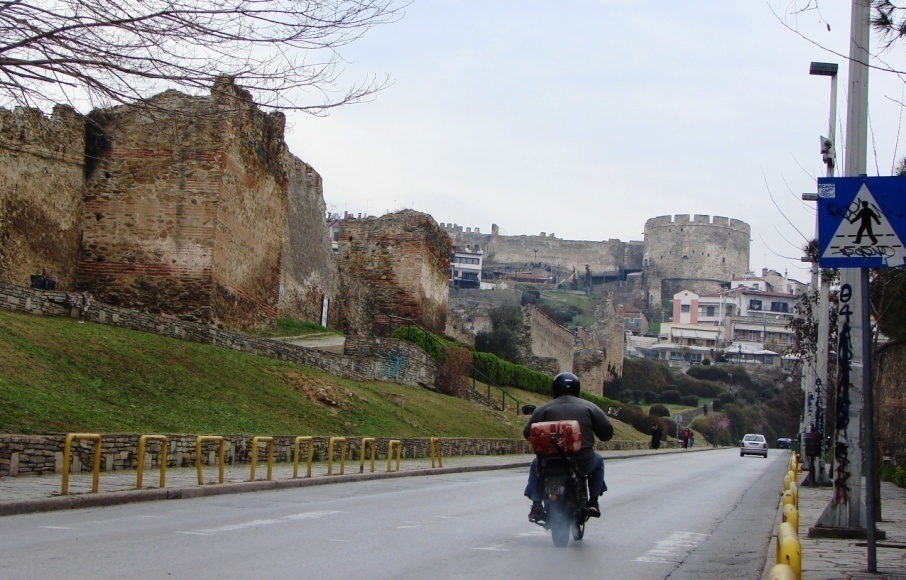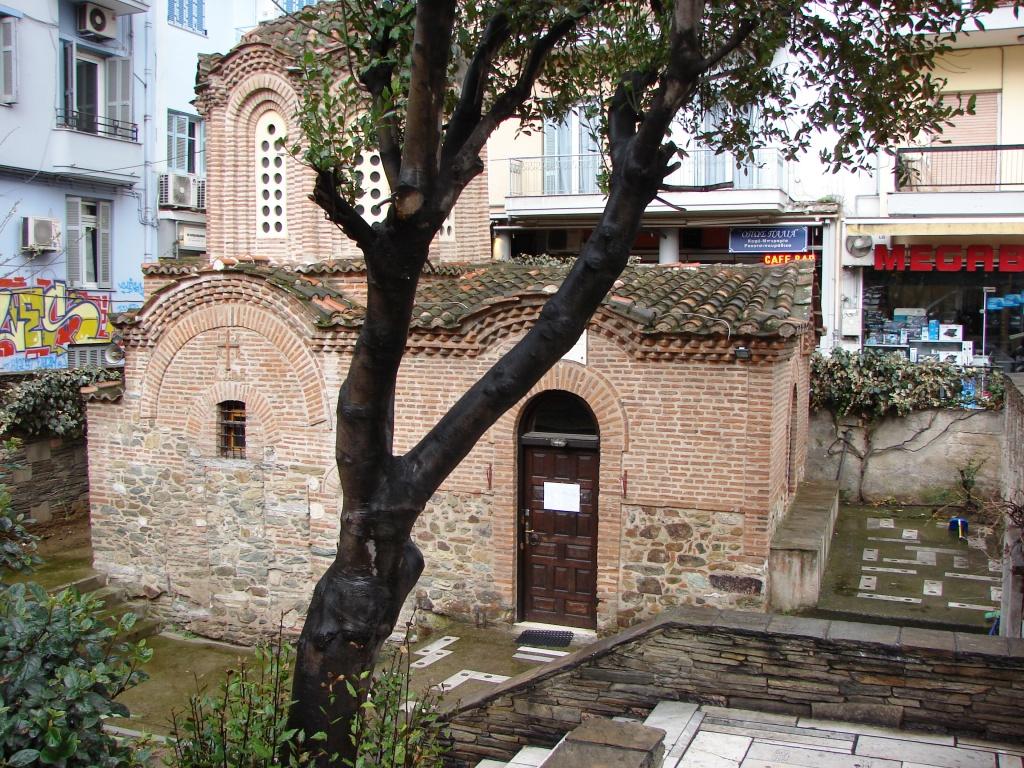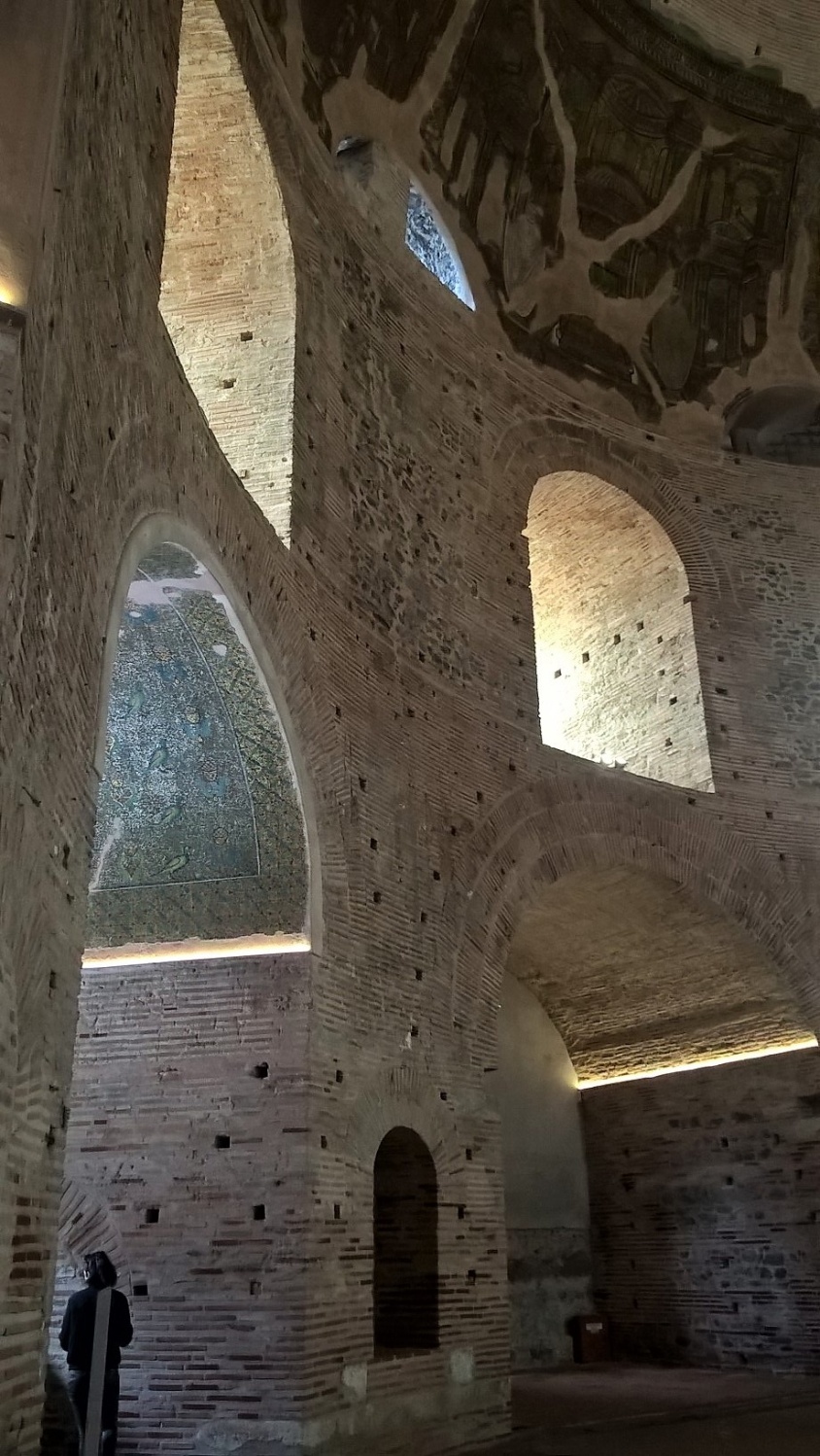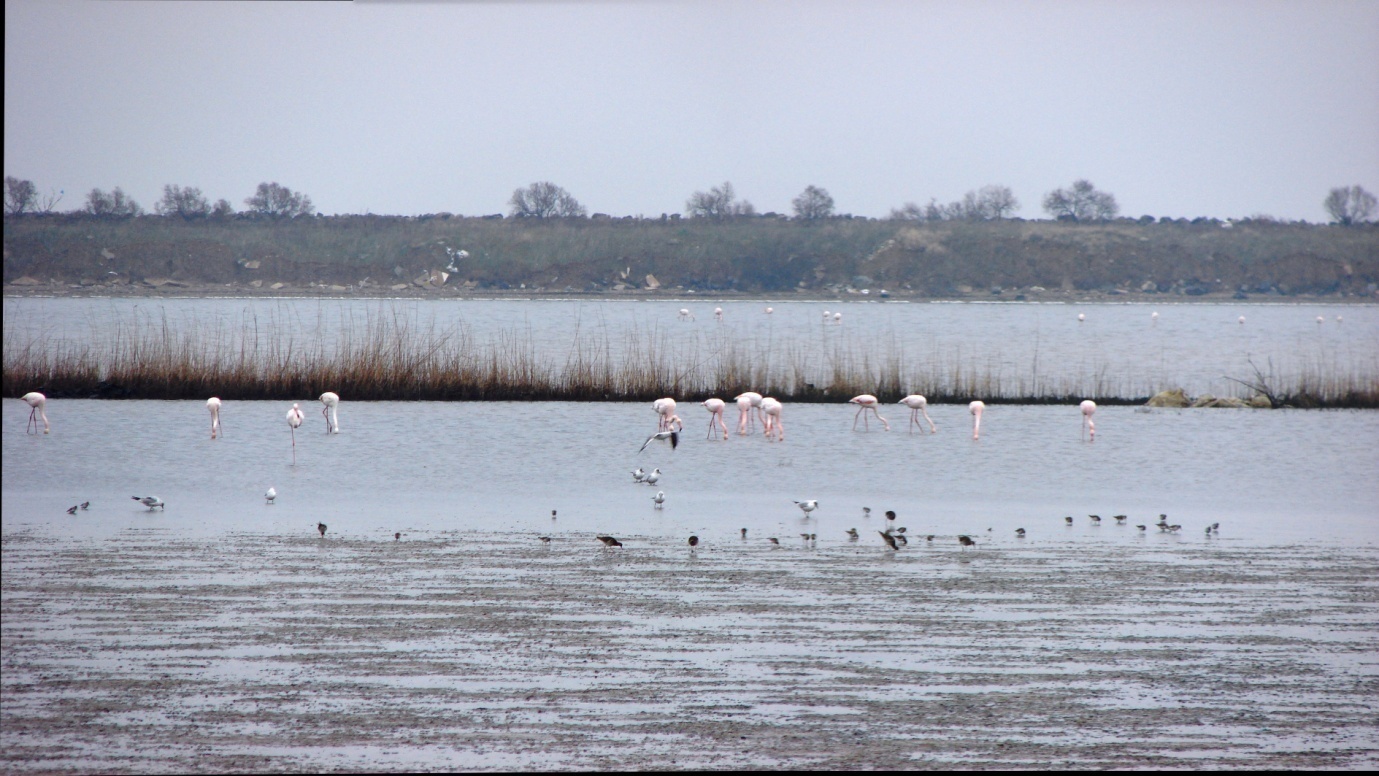The mystery of the disappearing tower.
Our first adventure on arrival in Thessaloniki was a late afternoon climb from the lower city up to the old town and the great fortress wall which runs along the ridge above. We climbed beside the Eastern wall, which once ran from the fortress all the way down to the sea half a mile away. The lower section has gone, but this part was more or less intact, constructed of cemented, uncut stones with a number of pleasing horizontal bands of thin red bricks. Roman-fashion. Up ahead there was a substantial round tower, set forward from the line of the ridge wall, which promised a fine viewpoint.

A turn in the road forced us to turn right before climbing again left, now obliquely, towards the fortress wall. The tower was no longer visible, lost behind the houses which lined the street and piled up the hill. It must come in to view again in a moment surely – or had we passed it somehow? We came to the wall but there was still no sign of the tower. We passed through a great arch gate to look for it behind the wall. The tower was not their either.
Back on the road there was a gate open leading to a monastery compound which promised a good view over the city and sea below. We went in. Perhaps the tower would be visible from there? An old church occupied the middle of the compound with modern buildings around. There were peacocks, chickens and Muscovy ducks in a large cage. The peacocks (body of an angel, voice of the devil) must be there, I surmised, to wake the monks for early morning offices – not to mention the town around. This was the Vlatadon Monastery, built in the 14th century during the late Byzantine Empire. The old pavements and church were accompanied by what looked like a very comfortable contemporary conference centre. The view from the compound wall was indeed splendid, with the city below and the wide horizon of a bay and the Gulf of Thermaïkós beyond. But there was no sign of the round tower left or right.
It was dusk by now and we descended through the steep maze of streets and back to the modern city, and a hostelry.
Next morning I sat on our hotel balcony drinking coffee. There was the round tower, back in its place in front of the fortress wall, just as if it had never been hiding.
*
Deep history
Thessaloniki is mostly a thoroughly modern city – laid out on a grid and too many shops. Wherever you go though, you find signs of its deep history. I say deep because, unlike the fortress walls, much of its ancient buildings are at various depths below conyemporary street level. Byzantine churches, large and small, tend to sit some three meters or so below; the excavated Roman agora (public space) in the centre of town, an acre or so in extent, lies about eight meters below. They were building a metro and I peered into one of its excavations to find archaeologists brushing soil off Roman plinths and paving a good twelve meters below. This, it occurred to me, must be getting very nearly down to sea-level, the promenade being only a couple of streets away. All was quite dry however.

3 metres below
The ancient building we enjoyed most was The Rotunda of Galerius. On the whole, it is a cylindrical though stepped structure of stone and red brick with a low-pitched tile roof. It reminded me of a lidded saucepan. Or a gasometre. However, it also has an attachment protruding at half height on one side. This is a chancel and apse added to the original Roman building a long time ago.
The Rotunda was caused to be built by the Roman Emperor Galerius in 306 AD, either as his mausoleum or as a Temple. In 326 it was converted into a Christian church on the orders of Constantine I, the Emperor who converted the Roman Empire to Christianity. It remained a church for about 1,200 years under the Byzantines, until, in 1430, the Ottomans arrived from Turkey. Quite what happened to the building immediately after that I cannot discover, but in 1590 the Ottomans made it a mosque and built a splendid minaret beside it, far taller than the Rotunda. After a few hundred years, Thessaloniki was won back by the Greeks – in 1912 – and the building was once more converted to an Orthodox church. It has since become a World Heritage Site.
There have of course been changes to the structure over the years. As noted, an apse and chancel have been added. An originally open occulus – a hole – at the top of the domed roof has been filled in and mosaiced. A series of sizable arched windows around the curved wall have been glazed. I couldn’t make my mind up whether these windows were part of the original design – in which case the interior would sometimes have been both windy and wet – or if they’d been added at some later stage. I think they must be original. The building survived a serious earthquake in 1978, and equally serious restoration work was required .

Its finest feature is its interior. You enter through a modest doorway and find yourself at the top of a descent of steps leading into an enormous circular space. Then you look up at the great domed roof made up of circle upon circle of thin red bricks, with pale mortar between, and the great occulus at its centre.
There are mosaics in gold, blue and red, both Islamic (decorative) and Orthodox (representational) on the walls, around the dome, on the apse ceiling, and in the entrance arches through the twenty feet thick walls. They are more and less complete. They are also not easy to see in the half light with the daylight through the arched windows closing one’s irises down a notch.
No problem, I liked the dome brickwork.
Unfortunately we accidently deleted all but one our photos of the Rotunda so I cannot show you the dome.
*
Birds
I took the No. 40 local bus from behind the Railway Station to Kalachori.
Where ? asked our Thessalonikan friends.
Edge of town, half an hour bus ride.
Never heard of it.
They had, however – and I should think so too – heard of the Axios Delta National Park. Or, to give it its full name, the Axios-Loudias-Aliakmonas National Park – 38,800 hectares of wetlands, a Ramsar Convention and a Natura 2000 site of International Importance. Dripping with birds. It begins at Kalichoria, 10 kilometres west of the centre of Thessaloniki, and then extends south-west along the western shore of the Gulf of Thermaïkós for twenty miles or so. Being reliant on public transport, Kalachori was the only practical point for me to get to. It was good enough. I walked down from the centre of ‘town’ – where the bus had deposited me – between grey suburban houses until at last I came to the edge . . .
Flamingos ! Tall – thin – pink – ridiculous. They were ranged over a wide lagoon bifurcated precisely by a wide gravel roadway leading to a distant perpendicular embankment. Or: the lagoon was divided in two by the roadway which ran straight ahead of me and an embankment beyond went from left to right, and vice-versa. Or even : there were two lagoons, left and right of a dead straight roadway, and in the distance, forming the horizon, an embankment.
You get the picture.
The flamingos were busy feeding, sieving the water for food in their customary upside-down way. Their frighteningly stick-thin legs bent obtusely as they stepped forward through the shallows. Their absurdly string-thin necks formed a gentle double curve – very art nouveau – as they reached down to the water and waggled their bills about. Why the devil not have a sensible length pair of legs and therefore a reasonable extent of neck to match ? They always feed in shallow lagoons so they really don’t need to be so absird. The answer is that no one really knows. They have been around for a long time – millions of years – so obviously they work.
To add to their oddity, DNA analysis suggests they are most closely related to grebes rather than to other stalky birds such as herons or cranes. Natural selection, it seems, can come up with some very peculiar results.

The flamingos were not alone. There were large numbers of redshank, dunlin, godwit, black-headed gulls and shelduck too. The lagoons were protected from the sea beyond by the embankment. According to an information board I met, they were in part created by the construction of the embankment, which was built to protect Kalachori from flooding. However, they were also the result of the land sinking, by as much as four metres, as fresh ground-water was pumped up to provide for the demands of Thessaloniki. Sea-water infiltrates from the south while rainwater runs in from the land to the north, producing shallow, brackish-water lagoons exactly suited to the requirements of the flamingos.

The pumping ended in about 1980, by which time the lagoons were well established and had become of major importance to birds as well as an important part of the National Park. Pity then that the lagoons have now been officially downgraded owing to a regular flow of polluted rainwater run-off and general rubbish emanating from Kalachori.
I reached the embankment, with the sea beyond, and turned right, along another roadway, the sea to my left, an expanse of rough, grey grassland with leafless bushes to my right. After some time I came to a cross-roads and turned left. I took shelter twice from passing rain – once in an abandoned concrete hut, then under an up-turned boat. Occasionally I passed someone walking the other way, but none looked up or said hello. Sometimes a vehicle passed by. Once or twice I walked past an empty vehicle parked at the side of the track for no obvious purpose; or wrecked huts, rubble and bits of broken boats. The whole place was a vast grid of gravel-tracked embankments extending dishearteningly into the distance.
But the birdwatching was terrific. It was one of those places where there were birds to see every few yards. And buffaloes. I thought they must be some local breed of cattle at first, but as I came closer I could see that they were domestic Asian buffalo (Bubalus bubalis). Dark-skinned, long-horned and mournful. Except that these were rather hairier than those I know from India, presumably in response to the local climate. They grazed the rough grassland to my right while minor murmerations of starlings rose up from among their feet, assembled on nearby electricity cables, and then descended again.
At the same time, a lark kept rising from the road in front of me as I walked. I knew it was a lark because it was short-tailed, brown- striated and very crested. Otherwise, I had to stop and look it up in my bird book. Crested lark (Galerida cristata). Common – and very crested. There are thirty-three recognised sub-species of this bird distributed across the middle of the old world from furthest west in Africa and Europe to China and the Korean Peninsular. They are divisible in such detail because they are particularly resident. They are to be found in northern France, for example, but only by very occasional accident in Britain. I felt fairly secure therefore in identifying these as G. c. meridionalis – otherwise known as the Grecian crested lark.
On my left, on the sea side, a line of noticeably small cormorants – or possibly shags – perched together on a wooden structure rising out of the water a few yards off-shore. I very nearly had a photo of them neatly lined up together, but they got spooked as I approached and departed. My bird book again : Pygmy cormorants (Microcarbo pygmeus), south-eastern Europe and south-western Asia – especially Greece and its neighbours.
Other birds were familiar – linnets, stonechats, hoodies and white wagtails on the grassland; ducks (pintail, teal , widgeon, mallard), waders (snipe, grey plover, oystercatcher, wood sandpiper) and ciconiiforms (grey heron, little and great egrets, spoonbill) among the shallow, muddy inlets to my right, after I had turned at the cross roads. There were mute swans here too. I checked every black-headed gull – black wing-tips- to see if was a Mediterranean gull – no black wing-tips. One, and only one, finally was.
I watched a gull harry a marsh harrier.
I finally decided I would go no further than a large building – perhaps a house – visible in the distance. It turned out to be an office of the government water management agency – with no one there. In front of it the roadway crossed a canal which was black and oily and stinking of untreated sewage. A little further on beyond though, there was a reed-bed busy with a great congregation of house sparrows, chattering, prattling, fluttering above and then disappearing down among the stalks and flower-heads. I decided they were probably out from town for the day on a feeding mission. It seemed too exposed a place to want to stay and roost overnight.
I left them feeding and headed back to town myself. First back to Kalachori, then Bus No. 40 to Thessaloniki Railway Station.
*